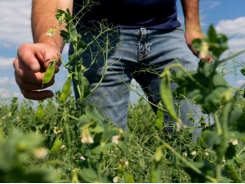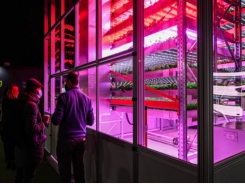How do you decide if your fruit trees need fertilizer? Ask an expert

Gardening season has wrapped up for most people, but there are always questions. For answers, turn to Ask an Expert, an online question-and-answer tool from Oregon State University’s Extension Service.
Most gardeners include fertilizer when planting new trees and shrubs. But what about once they've established? Photo: Victoria Coman News Staff
OSU Extension faculty and Master Gardeners reply to queries within two business days, usually less. To ask a question, simply go to the OSU Extension website type it in and include the county where you live. Here are some questions asked by other gardeners. What’s yours?
Q: I want to know when to fertilize fruit trees and what organic fertilize to use around the drip line? I want to get away from chemical sprays if possible. – Josephine County
A: You do not say what varieties of trees you have, however, here is a generic rule of thumb:
Trees and shrubs often are forgotten when it comes time to fertilize the yard in the spring. Young trees, especially those with a trunk diameter of less than 6 inches, can benefit from regular applications of fertilizer. When young trees soak up nitrogen fertilizer, they grow quickly, develop a dense canopy and stay green into the fall. It might not be necessary, however, to fertilize large, established trees or shrubs in or near lawns or groundcovers that are fertilized regularly.
Tree root systems extend for a long distance and they absorb nutrients when the area around them is fertilized. Additionally, as trees mature, their roots develop associations with fungi called mycorrhizae. These beneficial fungi help the tree utilize minerals and elements in the soil.
Before you fertilize, take a look at your trees and ask these questions to help you decide if your trees need additional nutrients:
How much annual growth do you see? Most young trees average about 12 to 18 inches of new shoot growth each year; older trees have less.
- Is your tree growing less than expected?
- Has the color, size or amount of foliage changed over the past few years?
- Has the tree recently had disease or insect problems?
If you answered yes to any of these questions, the tree might benefit from fertilization.
The best time to fertilize is in the spring. If you fertilize in the fall, you run the risk of shocking the plant into becoming metabolically active right when cold weather hits. Plus, a lot of the fertilizer will leach into the groundwater due to the excessive rain. Most woody plants begin the new year’s growth with elements stored from the year before. An application of fertilizer in the spring gives an additional boost to this new growth.
Garden references vary about how much fertilizer to apply to trees and shrubs. A general rule is to use 1/4 to 1/2 pound of nitrogen per inch of diameter for trees 6 inches or more in diameter at breast height. Use 1/4-pound actual nitrogen per inch on smaller trees. This is roughly 2 to 4 pounds of complete fertilizer per inch diameter on the larger trees and half that dosage on smaller trees. In most cases use the lesser amount. As time goes on, you will be able to tell by the condition of tree or shrub, whether or not it needs more fertilizer. Typically, healthy trees and shrubs have 12 to 18 inches of branch growth per year. Their leaf color should be dark green, with lighter green on new growth.
Apply the fertilizer along the drip line of the tree, the area with the majority of the roots. If the fertilizer is applied to the soil surface only, much can be washed away or will not filter into the soil to the root zone. Water the fertilizer or allow the rain to keep the fertilizer from washing away.
For quicker absorption, use a punch or probe to make holes 12 to 18 inches deep, and then fill the holes with fertilizer. Then be sure to water deeply.
Another way to fertilize is to “pepper” the ground with fertilizer as you walk around the drip line of the tree. This method should also provide an adequate amount of fertilizer. Apply fertilizer in this manner right before it rains, so it will be washed into the root zone. Or water the fertilized area for an hour after application.
Another way to determine fertilizer needs is to do a soil test.
Many organic all-purpose fertilizers are available at your local farmers’ co-op.
This yellowing daphne may need nitrogen
Q: I moved into a house in May and there is a lovely daphne out front that I’m very fond of. However, around June (sometime during or after that heatwave) it started to not look so good. I watered it, but think I may have over watered. Anyway, I thought it would improve as we got more rain, but it has not. – Lane County
A: This species is very susceptible to problems if it has inadequate drainage. Your over-watering suspicion may be accurate. I can’t tell from the photo whether the plant is in full sun, part shade/sun or full shade. This description of the plant tells you what its needs are.
Although the following Extension article is from California, it gives a bit more detail about care of this species, specifically pruning and fertilization. The yellowing leaves would indicate that it is in need of nitrogen, as directed in the article. I would also recommend that you mulch around the trunk – although not touching it- -- with a large bark chip, which will help to retain water in the summer and keep the soil cool, and protect the roots in the winter. Here is a brief information sheet on pruning that you might find helpful. – Kris LaMar, OSU Extension Master Gardener.
Có thể bạn quan tâm
Phần mềm

Phối trộn thức ăn chăn nuôi

Pha dung dịch thủy canh

Định mức cho tôm ăn

Phối trộn phân bón NPK

Xác định tỷ lệ tôm sống

Chuyển đổi đơn vị phân bón

Xác định công suất sục khí

Chuyển đổi đơn vị tôm

Tính diện tích nhà kính

Tính thể tích ao hồ




 How biotech crops can crash- and still never…
How biotech crops can crash- and still never…  How the Scottish are finding food solutions using…
How the Scottish are finding food solutions using…